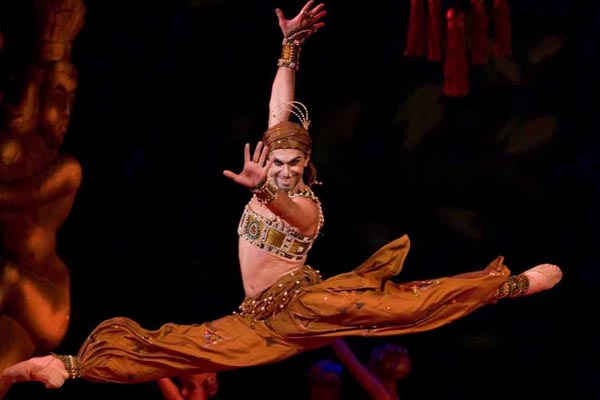
The late rescheduling of programmes caused by Ilza Liepa’s unexpectedly needing a second operation on a knee injury and the lack of a replacement dancer meant no “Cléopâtre – Ida Rubinstein,” Patrick de Bana’s telling of the making of the Diaghilev ballet, on this, what should have been the second programme of the Les Saisons Russes visit. “Should have been” because in fact what the audience got was simply two ballets from the rejigged programme one.
Prior to “The Firebird,” director Andris Liepa told something of the story of the recreation of the original sets. He was warm and engaging, although it didn’t make up for the unfortunate lack of a programme. Equally unfortunate was the use of recorded music. I’m not sure whether it’s merely that recordings were never designed to be played in such vast arenas, or whether theatre sound systems themselves are the problem, but as usual many of the delicate nuances in the score were lost. At least the volume was reasonable for a change. I do sometimes wonder whether a requirement for being a sound engineer is to be partly deaf.
Any recreation from something a century ago is only ever going to be a best approximation, but Anna Nezhnaya and Anatoly Nezhny’s take on Alexander Golvin’s original designs are certainly striking. The deep blues, purples, reds and greens leap out at you. The dance didn’t quite have the same effect, although the Kremlin Ballet’s Alexandra Timofeyeva was a spiky and feisty Firebird in her appropriately flame red tutu, although of the course the original costume was rather different.
Although the ballet has a dramatic sense, and even a few atmospheric moments, it tends to emphasise more cartoonish qualities a tad too often. The golden haired Prince Ivan, danced by Ilia Kuznetsov was likeable, even if he did look like one of those perfect princes found in Disney films. He was all exaggerated gesture; not always done to great effect. There was more Disneyesque imagery in the shape of Koschei, whose hunched figure prowled around the stage with plenty of evil intent, and dressed in the most marvellous skeletal costume. The star turn came from Natalya Balakhnicheva, a demure Princess of Unreal Beauty full of delightfully shy glances and smiles. The ladies provided contrast in their white robes, although their heavy-looking platinum blonde wigs weighed them down in more ways than one, and someone really does need to teach ballet dancers how to throw and catch apples. The other magical beasts provided some fun with their crazy leaps and turns.
Far more enticing was “Shéhérazade,” the story of what the slaves and the harem get up to when they think no-one is looking. Leon Bakst’s bold designs, full of clashing primary colours are a sight for sore eyes and so was the dance, although the ballet opens relatively slowly as the Sultan and his brother make plans to pretend to go hunting in what is in fact a ruse to catch out his concubine Zobiede, who he believes to be unfaithful. Once they have disappeared, the rest of the cast get on with the orgy and the dancing; and what dancing!
As Zobiede, Mariinsky Ballet principal Yulia Makhalina was quite scintillating. She flirted with the audience and the Golden Slave, danced by Nikolay Tsiskaridze, the outspoken Bolshoi principal who has been linked one way or another with many of the recent goings-on in that company, well and truly captivating both. Tsiskaridze has a powerful stage presence and brought real authority and strength to the role while still managing to show plenty of passionate desire for his woman. I’m not sure I’ve ever seen a male dancer look so happy to be where he was. His soaring split jetés and lightning-fast pirouettes in second brought gasps from the audience. Best of all was the way the electricity flowed between them, the stage crackling and sparking with raw emotion as they danced out their love for each other in the sensual and sexy pas de deux. Who needs pointework when ballet is like this?
Elsewhere, the odalisques, danced by Yuliya Voronina, Valeriya Pobedinskaya and Alia Khasenova were a delight. The Chief Eunuch is a bit of a pantomime role, but Roman Volodchenkov bumbled around to great effect. The rest of the harem gave their all too as the tension built and built towards the Sultan’s return, the killing of the Slave and Zobiede’s spine shivering suicide.
Liepa does struggle for resources, and maybe with some of recreations he overreaches himself occasionally, but who really knows what ‘original’ means anyway? During one of his chats to the audience, he said that he hoped to bring “Cléopâtre” to London next year. I for one hope he makes it.
David Mead

